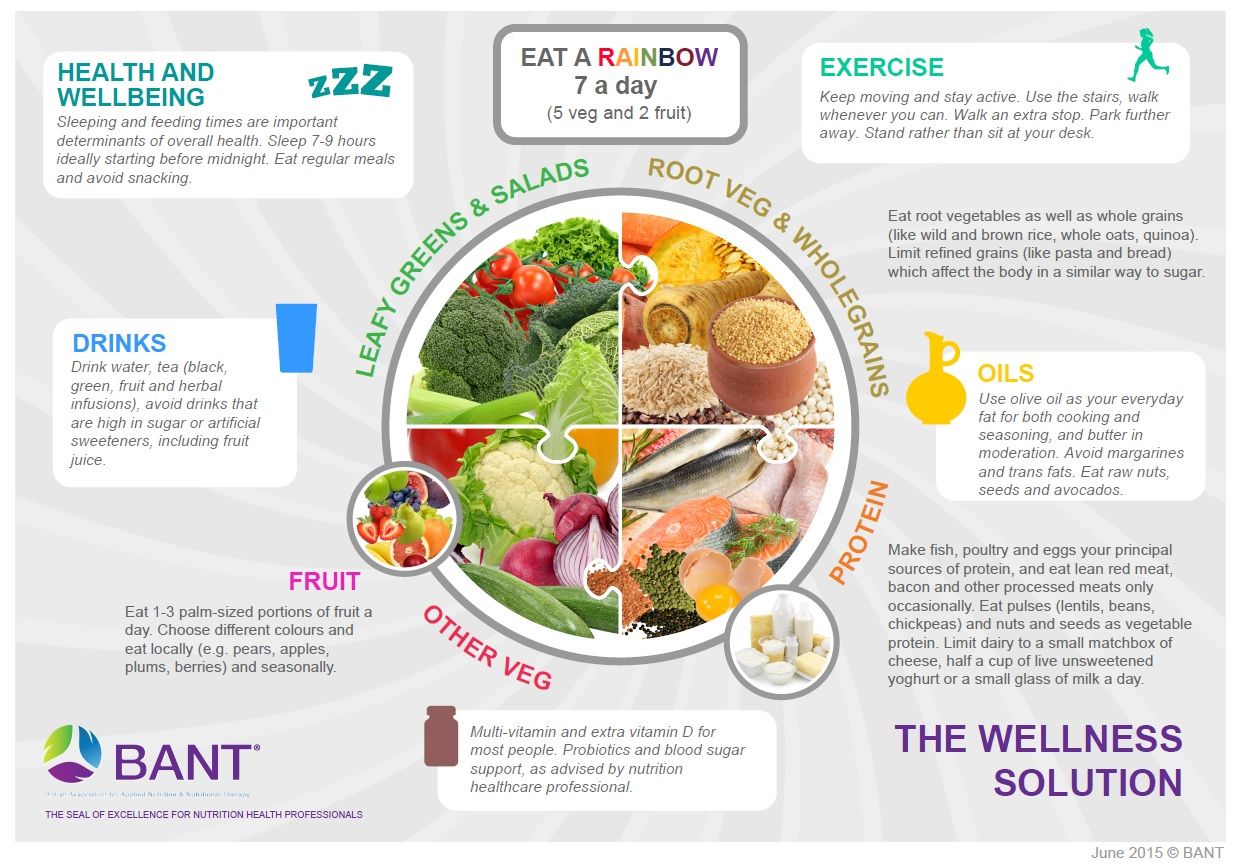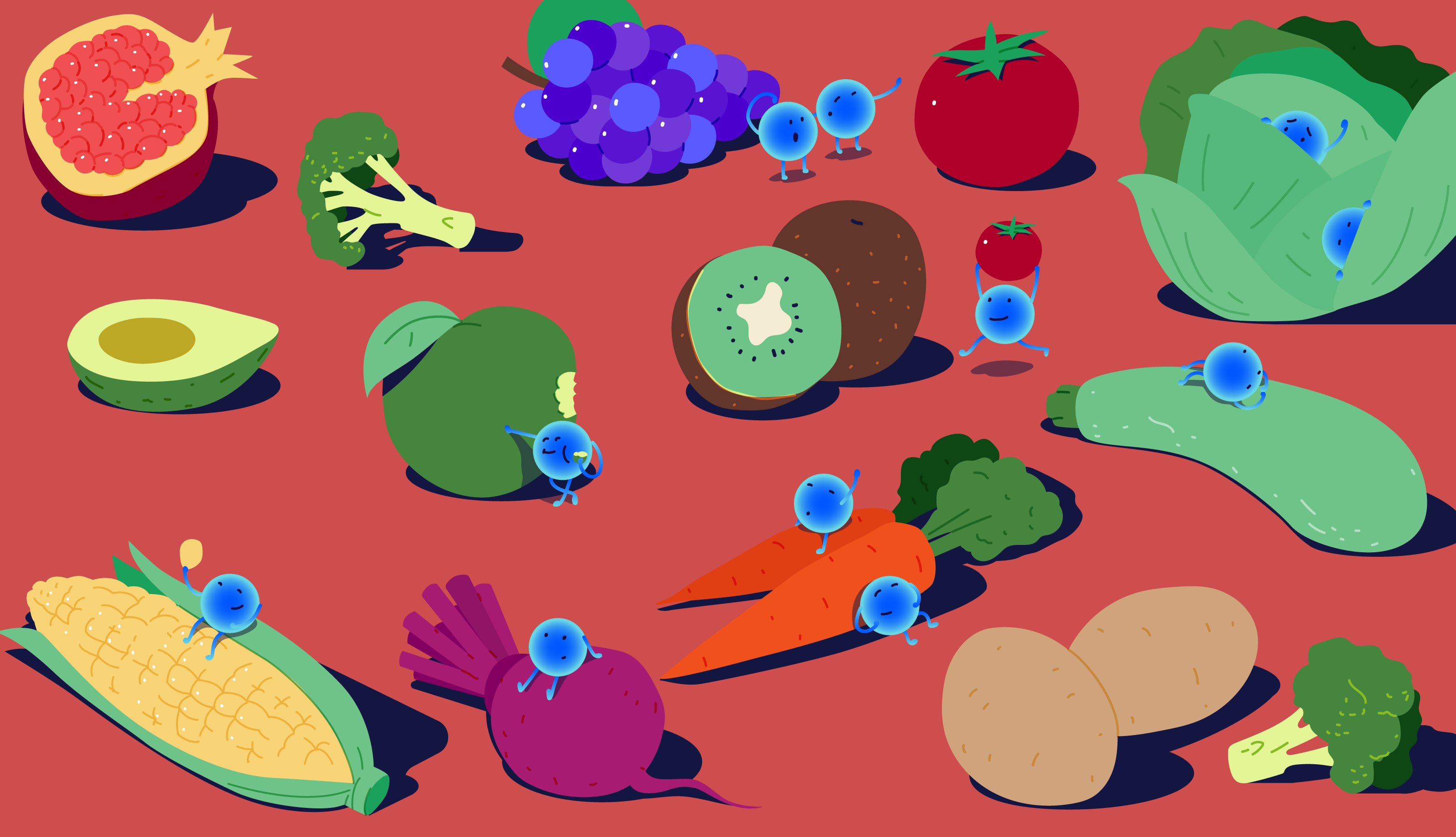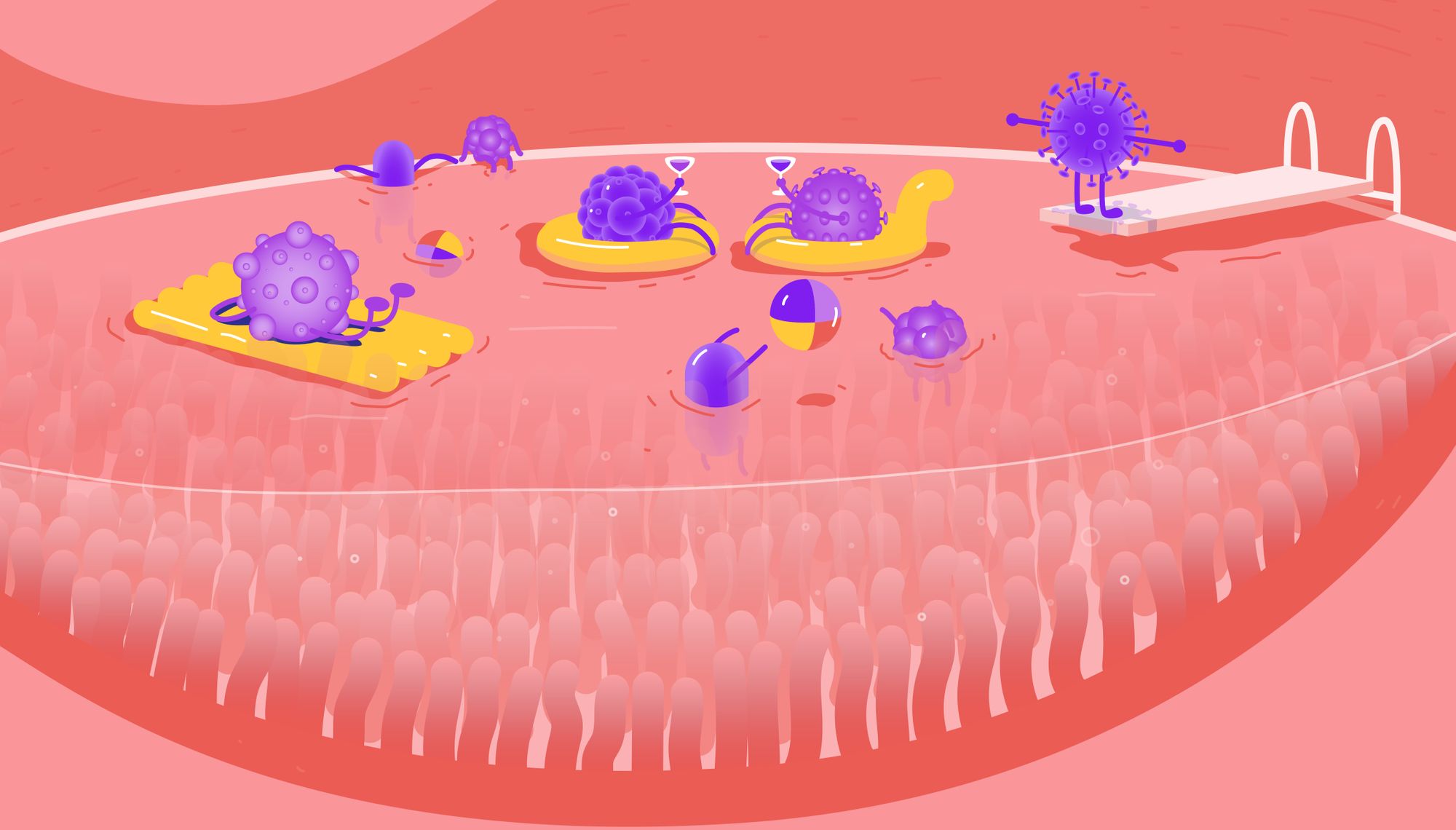Here’s the down-low on fibre, what foods you get it from, why it’s good for your body and what your gut microbes have to do with it.
The World Health Organisation recommends eating 400g (or 5 servings) of fruit and vegetables per day for adults. That’s about 30g of fibre. In the UK, it’s estimated that men and women are only getting about two-thirds of the recommended fibre intake (17.2g and 20.1g respectively).
In fact, dietary fibre consumption is generally below-par in Europe and North America. Yet, this is not surprising considering the rise in processed and fast food consumption, both of which have exchanged high fibre for high sugar, fat, and animal protein.
Table of contents
- What is dietary fibre?
- Soluble vs insoluble fibres
- Prebiotics, fibre and the gut microbiome
- Fibre nourishes probiotics in your gut
- Butyrate, fibre and beneficial bacteria
- How fibre keeps your body healthy
- How to build a high fibre diet
However, fibre isn’t just a bulking agent to ease your (hopefully) daily bowel movement, it’s an essential cog in your body’s mechanics, and a vital source of sustenance for beneficial bacteria in your gut.
In this article, we break it all down for you in simple terms that won’t make your head spin. Discover what fibre is and why it’s a bit more complicated than just soluble and insoluble. We’ll also review the many benefits of a high fibre diet, and what foods to eat.
☝️DISCLAIMER☝This article is for informational purposes only. It is not intended to constitute or be a substitute for professional medical advice, diagnosis, or treatment.
What is dietary fibre?
Dietary fibre comes from plants: it’s made from complex structures in plant cells that can’t be completely broken by the human digestive system.
Our bodies only produce a limited number of enzymes dedicated to transforming our food into nutritive substances, and fibres from plants tend to resist this activity. That’s why some people call it roughage: it was traditionally conceived as a means to encourage or moderate the frequency of bowel movements.
In previous decades, soluble and insoluble fibre were the preferred descriptors for these substances. Here we explain the function of fibre in the diet.
Soluble fibre
Soluble fibre dissolves in water, and many soluble fibres (but not all) have a viscous texture. These gelling properties have been directly linked to several health benefits:
- Blood sugar: soluble fibre slows the absorption of macronutrients from food, especially sugars. By doing so, it helps stabilise blood glucose levels, which makes it beneficial for people with insulin resistance, metabolic syndrome, prediabetes, and type 2 diabetes.
- Blood cholesterol: soluble fibre traps cholesterol from food, preventing it from being absorbed. This helps lower levels of low-density lipoprotein (LDL) cholesterol and total blood cholesterol, which can help prevent and manage heart disease.
- Bile acids: bile acids help break down fats and collect by-products of metabolism. Soluble fibre traps bile so it exits the body in the stool. The body uses cholesterol to make bile, and thus, helps lower blood cholesterol levels.
- Hunger & weight loss: studies in humans show that soluble fibre has the ability to increase satiety (feeling of fullness) and delay hunger for longer. This plays a role in energy balance. Indeed, research also indicates that soluble fibre can help with weight loss and improve body mass index (BMI) in overweight and obese patients.
- Gut microbiome: soluble fibres transit through the digestive tract to the colon where they encounter our gut microbes. They are considered to have prebiotic properties because they are fermented (broken down) by beneficial bacteria in the gut to produce essential short-chain fatty acids.
Insoluble fibre
Insoluble fibre is resistant to the activity of human digestive enzymes, so it remains intact as it travels through the gastrointestinal tract. The gut microbiota has little effect on insoluble fibre, which is at best slowly fermented and often, not at all.
- Constipation: insoluble fibre isn’t broken down by the body. Instead, it irritates the gut lining, provoking the release of mucus and water by the gut lining. Insoluble fibre absorbs the water, adding bulk to the stool, and the additional mucus helps stool transit through the body and to the exit in a timely manner.
Prebiotics, fibre and the gut microbiome
Several types of dietary fibres found in plant-based foods provide an important source of sustenance for the trillions of bacterial cells in our gut. Scientists describe them as prebiotics.
In order to be considered a prebiotic, various types of dietary fibres have been tested for and fulfilled several requirements:
- non-digestible by human enzymes
- stimulates growth or activity of beneficial bacteria
- has a positive impact on human health
If you’ve taken our test, you’ll have noticed an extensive list of hard-to-pronounce words in your Dietary fibre report. These are prebiotic dietary fibres found in your food.
Like humans, bacteria can be picky. They don’t just ferment any fibre, they have preferences when it comes to what they can work with. This has been confirmed by extensive research on humans, animals, and in test tubes.

So when we test your stool for the composition of your gut microbiome, we can tell how efficient your microbes are at breaking down dietary fibre based on which ones live in your gut and at what levels.
We’ve summarised this information in helpful short descriptions based on traits benefited by different fibre types and their food sources. Our team also use these food sources to develop your personalised weekly food recommendations designed to optimise the composition of your gut microbes.
To help your gut bacteria thrive using the food recommendations from the Atlas Microbiome Test, your diet should contain 30g of fibre per day.
Fibre improves microbiome diversity

Diversity is an important trait to measure gut microbial health. Greater diversity is found in healthy hosts (yes, we’re the hosts), while below-average diversity is a sign of an imbalanced microbiome that can’t support our health as well as it should.
Gut microbes are also complementary, meaning they perform activities that benefit others, and in turn, this benefits us. For example, probiotic microbes called Bifidobacteria produce acetate and lactate that are used by beneficial microbes called Firmicutes who turn them into butyrate, a critical nutrient for gut health.
At the same time, different types of bacteria can perform the same health-promoting function. This is important because sometimes bad things happen to microbes that can wipe out a species, like an infection, change in dietary habits, acute stress or antibiotics. If this happens, other bacteria that perform the same role, like making butyrate, can compensate for this loss.
Fibre nourishes probiotics in your gut
Having a diet rich in different types of dietary fibre encourages diversity and stimulates the growth of probiotic bacteria like lactic acid bacteria and Bifidobacteria.
These microbes are able to balance the pH in the gut, prevent inflammation, modulate the immune system, deter pathogens, and can even improve mood and stress resilience.
| Benefit | Dietary fibre | Food Sources |
| Bifidobacteria growth | Arabinan, arabinoxylan, dextrin, FOS*, GOS*, galactomannan, MOS* | Beetroot, rye, barley, oats, milk, chicory, Jerusalem artichokes, onions, garlic, maitake mushrooms, S. cerevisae (baker’s yeast). |
| Lactobacillus growth | Dextrin, FOS, inulin, galactan, galactomannan, lactulose, pullulan, pyrodextrin, | Cooked starches, rye, wheat, onions, garlic, legumes, milk, chicory, Jerusalem artichokes, red seaweed, maitake mushrooms |
FOS: fructooligosaccharides; GOS: galacto-oligosaccharides; MOS: mannan-oligosaccharides
Butyrate, fibre and beneficial bacteria
Beneficial bacteria do at least one health-promoting job in the gut. In particular, some of them produce butyrate, an essential short-chain fatty acid that prevents inflammation and helps maintain the integrity of the gut barrier.
Butyrate producers include members of the Firmicutes phylum like Faecalibacterium prausnitzii and Roseburia, and others like Eubacterium.
Some microbes, like Akkermansia, have other beneficial effects. Akkermansia is present in the gut of lean people and can help with body weight control and maintaining a healthy body mass.
| Benefit | Dietary fibre | Food Sources |
| Butyrate | Arabinoxylan, inulin, pectin, beta-glucan, polydextrose | Rye, barley, oats, chicory, jerusalem artichokes, onions, garlic, apple, citrus, berries, blackberries, cranberries, whole grains, cereal bran, mushrooms |
| Butyrate-producers | Arabinoxylan, pectin | Rye, barley, oats, apples, citrus, berries, blackberries, cranberries |
| Akkermansia | Arabinoxylan | Rye, barley, oats |
FOS: fructooligosaccharides; GOS: galacto-oligosaccharides
How fibre keeps your body healthy
Adding fibre to your diet can improve several markers of health thanks directly and indirectly via the action of beneficial and probiotic microbes.
As we mentioned, it can improve blood glucose and cholesterol levels that are linked to chronic diseases like diabetes type II and cardiovascular diseases. Via the interaction with gut microbes, it can also control and reduce inflammation - chronic inflammation is associated with many common diseases.
It has also been shown to enhance immune function, frequency of bowel movements and lower appetite. Inulin, a fibre that can make you gassy (there we’ve said it) can even improve mineral absorption in the gut.
| Benefit | Dietary fibre | Food Sources |
| Satiety, reduced hunger | Dextrin, polydextrose | Wheat, potatoes, rice |
| Improved blood sugar | FOS, resistant starches, pyrodextrin | Legumes, pulses, wheat, rye, onions, garlic, cooked starches, green bananas, cooled potatoes and pasta |
| Inflammation, immune function | Arabinogalactan, beta-glucan, FOS, GOS, Xylo-oligosaccharides | Radishes, carrots, pears, tomatoes, cereal bran, whole grains, mushrooms, legumes, pulses, wheat, rye, onions, garlic, chamomile & echinacea (don’t exceed 10g per day) |
| Improved blood cholesterol | Beta-glucan, cellulose | Cereal bran, whole grains, mushrooms, most edible plants |
| Bowel movements | Beta-glucan | Cereal bran, whole grains, mushrooms |
| Calcium, magnesium absorption | Inulin | Chicory, jerusalem artichokes, onions, garlic |
FOS: fructooligosaccharides; GOS: galacto-oligosaccharides
How to build a high fibre diet
High fibre diets aren't not complicated. They're perfectly summarised by award-winning food and health author, Michael Pollan, in his book Food rules, an eater's manual: “Eat food. Not too much. Mostly plants.”
And it’s very good advice. Your diet should contain at least 30g of fibre every day from whole foods. Whole foods are easily identifiable in the supermarket: they’re out on display, unpackaged, in all their glory.
We like the dietary guidelines by the British Association for Nutrition and Lifestyle Medicine. They want us to eat the rainbow, and aim for 5 servings of vegetables and 2 fruit per day in many different hues and colours.

It can be a struggle to find the right balance at first: many people make the mistake of eating too many leaves, vegetables, and fruit, but not enough fillers like grains and pulses. These are the ones that will keep you full.
There’s also too much pressure nowadays to make instagrammable food, but food is for the body, not the eyes. Fortunately for you, this author is not only a health writer, she’s a trained chef - and she makes food like this every day.
Here’s a basic guide to making stunning dishes that will please your palate, your eyes, and your guests with minimal effort and maximum satisfaction.
1. Primary: choose a staple (or, even better, several).
- Whole grains: wheat, rye, barley, oats, quinoa, buckwheat (whole flour, grains, porridge)
- Legumes & pulses: beans, lentils, chickpeas.
- Starches: potatoes (cooked and cooled), plantain, brown rice
2. Secondary: use lots of these
- Vegetables: raw, roasted, boiled, wilted, sauteed
- Fruit: mostly fresh, sometimes dried, best for breakfast and desert
- Leafy greens: fresh, or wilted, adjust quantity based on bitterness
- Mushrooms: don't forget the fungi!
3. Fats: your body needs them
- Olive oil: mix it in or drizzle on top
- Avocado: it’s delicious and has lots of fibre
- Greek yoghurt: a probiotic, creamy delicious topping
4. Topping & seasoning: in moderation (it’s not ketchup)
- Seeds & nuts: use raw to add crunch to your dish
- Citrus: season with citrus juice
- Herbs: small leaves with lots of flavour
- Spices: get inspiration for spice combinations from cookbooks
- Turmeric: add pepper to increase levels of active compound
- Salt: in moderation, it’s essential and enhances flavour
- Nutritional yeast: adds a cheesy flavour, best on cooked foods
5. Protein: you don’t need meat for every meal
- Red meat, seafood & oily fish: no more than once a week each
- White meat & eggs: in moderation
- Plant protein: pulses, legumes and tofu
You can learn from their combinations of spices, herbs, and seasonings, but you don’t need to follow a cookbook to make great meals, you just need to taste as you prepare the dish. That’s the secret to good food.
Don’t forget to follow us on Instagram @atlasbiomed where Leigh shares simple recipes to make great food that’s good for your body, gut microbes and mind. You can also check out our recipes section on the blog.
Get your personalised food recommendations with 10% off the Atlas Microbiome Test when you sign up for the blog updates!
- ED Jesch & TP Carr, Food Ingredients That Inhibit Cholesterol Absorption, 2017
- SV Thompson et al., Effects of isolated soluble fibre supplementation on body weight, glycemia, and insulinemia in adults with overweight and obesity: a systematic review and meta-analysis of randomized controlled trials, 2017
- J Slavin & H Green, Dietary fibre and satiety, 2007
- D Dhingra et al., Dietary fibre in foods: a review, 2012
- World Gastroenterology Organisation, Diet and the gut guidelines, 2018



















